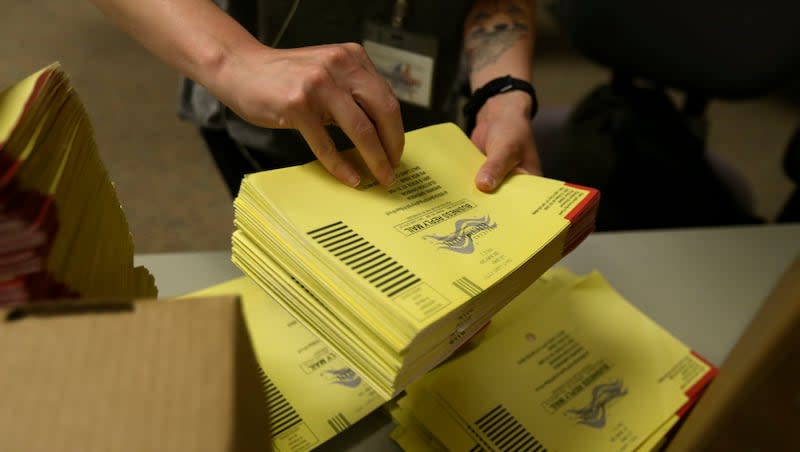County clerks in Utah are mailing ballots. Here’s what to know about voting

Tuesday marks the day county clerks will send out mail-in ballots to every active registered voter in Utah for the primary election.
County clerks will send out ballots between Tuesday and June 18 ahead of the primary election on June 25. If you don’t receive your ballot shortly after the June 4 to June 18 window, contact your county clerk.
Here’s a look at how to vote in Utah’s primary election as well as some information about where to find the candidates you’ll be voting on.
How to vote in Utah’s primary election
Registered voters in Utah have three options — mail-in ballots, drop boxes and in-person voting.
Your ballot either needs to be postmarked on or by June 24 or dropped off at a drop box location before 8 p.m. on Election Day (June 25), according to Utah’s election website.
The website also stated some counties have prepaid postage and others do not. Ballots without stamps sent in the mail will still be delivered to the county clerk’s office by the Postal Service. You don’t need a stamp to drop your ballot in a drop box either.
For example, in Utah County, the ballots say that postage is required. Utah County Clerk Aaron Davidson told the Deseret News ballots will still reach the county clerk’s office if mailed without postage, but he wanted to encourage the use of drop boxes and in-person voting during the election.
In addition to saving the county money, Davidson said they had “better custody over the ballots” when voters use the drop boxes.
The county will be billed if ballots are sent without postage. Davidson said “it defeats the purpose of trying to save taxpayer money and defeats the purpose of custody issues.” Lt. Gov. Deidre Henderson said on social media, “If you don’t have a stamp you can mail it in anyway, it’ll still be delivered to your county clerk, and they’ll be billed for the postage.”
As for in-person and drop box voting, locations will depend on where you live. You can visit Utah’s election website to learn more about where you can drop off your ballot and where you could vote in person on Election Day.
How to register to vote in Utah
The deadline to register to vote is June 14 by 5 p.m. — that’s when the county clerk needs to have received your voter registration. You can also register to vote at an early voting location or polling location on Election Day if you bring at least two forms of identification with you.
Acceptable forms of identification include Utah drivers license, U.S. passport, tribal ID card, currently valid U.S. military ID card and others. See the voter ID requirements page on the Utah election website for more information.
It is important to note the deadline to change your political party affiliation was on Jan. 9, 2024. The Utah Republican Party has closed primaries, meaning that only registered Republicans can vote in the primary election. If you’re an unaffiliated voter, you can affiliate as either Republican or Democrat before June 18. But if you’re a Democrat, you can’t switch to Republican and get a Republican primary ballot.
What candidates will be on the ballot?
There are statewide races, regional races and local races that appear on ballots — your party affiliation will determine who you see on the ballot.
Some of the races Utah voters will see on their ballots are governor, senate, attorney general, state auditor and more. To find out which candidates will appear on the primary ballots, visit the Utah election website and see which candidates have “primary” as their status.
As an example, look at the governor’s race. Incumbent Gov. Spencer Cox is in a primary election with Phil Lyman. On the other hand, Brian King (Democratic), J. Robert Latham (Libertarian), Tom Tomeny (unaffiliated) and Tommy Williams (Independent American) are election candidates. Unless they drop out, they will be on the November ballot for the general election.
In the Senate race, Rep. John Curtis, Trent Staggs, Jason Walton and Brad Wilson are candidates in the Republican primary. Caroline Gleich (Democratic) and Carlton E. Bowen (Independent American) are general election candidates — they don’t have a primary.
When can we expect primary election results?
After the polls close on Election Day, live election results will be available on the Utah elections website. In some cases, it can take days for the final results to come in.
What happens after primary elections?
After the primary election, some candidates will be eliminated and others will advance to the general election. There will be one candidate per party maximum for each race ahead of the November general election.
